初中英语语法知识点整理总结
初中英语语法知识点总结
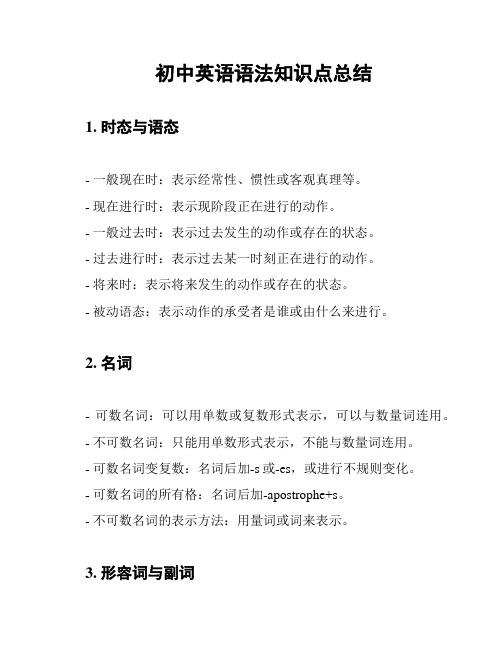
初中英语语法知识点总结1. 时态与语态- 一般现在时:表示经常性、惯性或客观真理等。
- 现在进行时:表示现阶段正在进行的动作。
- 一般过去时:表示过去发生的动作或存在的状态。
- 过去进行时:表示过去某一时刻正在进行的动作。
- 将来时:表示将来发生的动作或存在的状态。
- 被动语态:表示动作的承受者是谁或由什么来进行。
2. 名词- 可数名词:可以用单数或复数形式表示,可以与数量词连用。
- 不可数名词:只能用单数形式表示,不能与数量词连用。
- 可数名词变复数:名词后加-s或-es,或进行不规则变化。
- 可数名词的所有格:名词后加-apostrophe+s。
- 不可数名词的表示方法:用量词或词来表示。
3. 形容词与副词- 形容词用于修饰名词,副词用于修饰动词、形容词或其他副词。
- 形容词的比较级:形容词原级后加-er,或用more或less加形容词原级构成比较级。
- 形容词的最高级:形容词原级后加-est,或用most或least加形容词原级构成最高级。
- 副词的比较级和最高级:在形容词的原级前加more或less构成比较级,加most或least构成最高级。
4. 代词- 人称代词:主格代词用于作主语,宾格代词用于作宾语或介词的宾语。
- 物主代词:用于表示所有关系。
- 反身代词:用于表示动作反过来作用于主语本身。
- 指示代词:用于指代特定的人或事物。
- 疑问代词:用于提问特定的人或事物。
- 不定代词:表示泛指或不确定的人或事物。
5. 冠词- 定冠词:表示特指某一个人或物。
- 不定冠词:表示泛指某一个人或物。
- 零冠词:有些名词前不用冠词。
6. 介词与介词短语- 介词:用于表示时间、地点、方向、状态、方式等词义。
- 介词短语:由介词和其后的宾语构成。
以上是初中英语语法知识点的基本总结,希望对您有所帮助。
如果有任何疑问,请随时向我提问。
总结初中英语语法知识点(集合7篇)
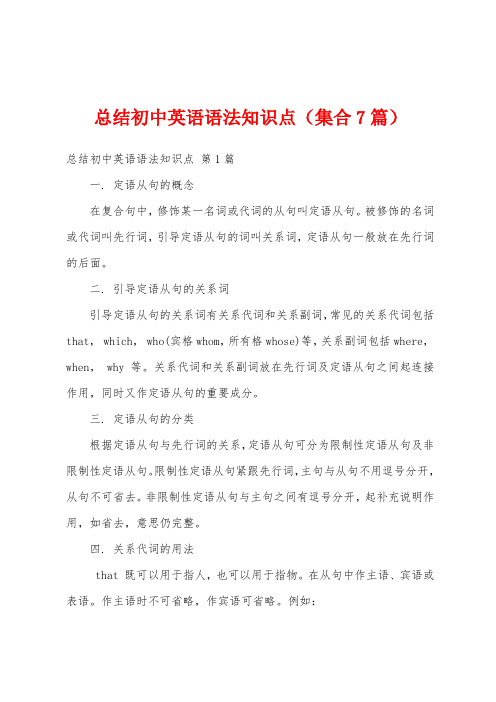
总结初中英语语法知识点(集合7篇)总结初中英语语法知识点第1篇一. 定语从句的概念在复合句中,修饰某一名词或代词的从句叫定语从句。
被修饰的名词或代词叫先行词,引导定语从句的词叫关系词,定语从句一般放在先行词的后面。
二. 引导定语从句的关系词引导定语从句的关系词有关系代词和关系副词,常见的关系代词包括that, which, who(宾格whom,所有格whose)等,关系副词包括where,when, why等。
关系代词和关系副词放在先行词及定语从句之间起连接作用,同时又作定语从句的重要成分。
三. 定语从句的分类根据定语从句与先行词的关系,定语从句可分为限制性定语从句及非限制性定语从句。
限制性定语从句紧跟先行词,主句与从句不用逗号分开,从句不可省去。
非限制性定语从句与主句之间有逗号分开,起补充说明作用,如省去,意思仍完整。
四. 关系代词的用法that 既可以用于指人,也可以用于指物。
在从句中作主语、宾语或表语。
作主语时不可省略,作宾语可省略。
例如:Mary likes music that is quiet and玛丽喜欢轻柔的音乐。
(that作主语)The coat (that) I put on the desk is我放在桌子上的那件外套是蓝色的。
(that作宾语)用于指物,在句中作主语、宾语或表语。
作主语不可省略,作宾语可省略。
例如:The building which stands near the train station is a 位于火车站附近的那座大楼是一家超市。
(作主语)The film (which) we saw last night was我们昨天晚上看的那部电影很好看。
(作宾语), whom用于指人,who 用作主语,whom用作宾语。
在口语中,有时可用who代替whom。
who和whom作宾语时也可省略。
例如:The girl who often helps me with my English is from 经常在英语方面帮助我的那个女孩是英国人。
初中英语语法知识汇总 终极版

初中英语语法(完整版)一.名词I.名词的种类:II. 名词的数:1. 规则名词的复数形式:名词的复数形式,一般在单数形式后面加-s或-es。
现将构成方法与读音规则列表如下:III. 名词的所有格:名词在句中表示所有关系的语法形式叫做名词所有格。
所有格分两种:一是名词词尾加’s 构成,二是由介词of加名词构成。
前者多表示有生命的东西,后者多表示无生命的东西。
3. of所有格的用法:用于无生命的东西:the legs of the chair, the cover of the book用于有生命的东西,尤其是有较长定语时:the classrooms of the first-year students 用于名词化的词:the struggle of the oppressed二.冠词冠词分为不定冠词(a, an),定冠词(the),和零冠词。
I.I.代词可以分为以下七大类:II. 不定代词用法注意点:1. one, some与any:1) one可以泛指任何人,也可特指,复数为ones。
some多用于肯定句,any多用于疑问句和否定句。
One should learn to think of others.Have you any bookmarks? No, I don’t have any bookmarks.I have some questions to ask.2) some可用于疑问句中,表示盼望得到肯定的答复,或者表示建议,请求等。
Would you like some bananas?Could you give me some money?3) some 和any修饰可数名词单数时,some表示某个,any表示任何一个。
I have read this article in some magazine.Please correct the mistakes, if any.4) some和数词连用表示“大约”,any可与比较级连用表示程度。
初中英语语法常考知识点汇总

初中英语语法常考知识点汇总1.动词时态:包括一般现在时、一般过去时、一般将来时、现在进行时、过去进行时、过去将来时等。
2.祈使句:用于表达请求、命令或建议的句子,常用动词原形作谓语。
3. there be句型:用于表达存在、有或发生的句子结构,后跟名词、代词等。
4. 介词:用于表示时间、地点、方式、目的等关系的词语,常见的有in, on, at, from, to等。
5.比较级和最高级:用于比较两个或多个事物的程度高低的形式,常用的比较级有比较形容词和副词的比较级,最高级有比较形容词和副词的最高级。
6.数词:用于表示数量的词语,包括基数词和序数词。
7.名词和代词:用于表示人、事、物的名称的词语。
8.形容词和副词:用于描述人、事、物的性质、状态等的词语。
9.句子的主谓一致:主语和谓语动词在人称和数上保持一致。
10. 定语从句:用于修饰名词或代词的从句,通常由关系代词who, whom, whose, which等引导。
11.宾语从句:用于充当及物动词或介词的宾语的从句。
12. 状语从句:用于修饰动词、形容词、副词等的从句,通常由连词when, where, because, although等引导。
13.反意疑问句:由一个陈述句和一个疑问句组成,用于征求对方的意见、确认对方的观点等。
14. 间接引语:用于转述别人的话的句子,常用连词that引导。
15. 情态动词:用于表示说话人的意愿、能力、允许等情态的动词,常见的有can, may, must, should, could, might, would等。
16.被动语态:用于表示动作的承受者在句中位置比较靠前的句子结构。
17.独立主格结构:由名词或代词加上现在分词或过去分词构成,在句中作状语。
18.虚拟语气:用于表示与事实相反、假设的语气。
初中英语语法大全知识点总结
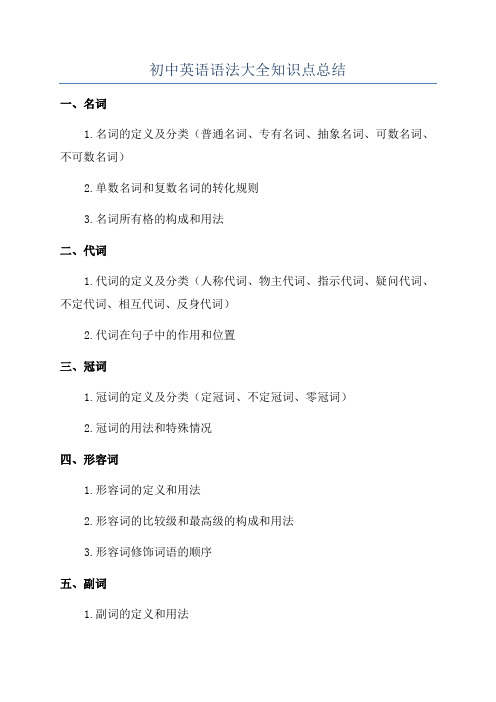
初中英语语法大全知识点总结一、名词1.名词的定义及分类(普通名词、专有名词、抽象名词、可数名词、不可数名词)2.单数名词和复数名词的转化规则3.名词所有格的构成和用法二、代词1.代词的定义及分类(人称代词、物主代词、指示代词、疑问代词、不定代词、相互代词、反身代词)2.代词在句子中的作用和位置三、冠词1.冠词的定义及分类(定冠词、不定冠词、零冠词)2.冠词的用法和特殊情况四、形容词1.形容词的定义和用法2.形容词的比较级和最高级的构成和用法3.形容词修饰词语的顺序五、副词1.副词的定义和用法2.副词的比较级和最高级的构成和用法六、动词1.动词的定义和分类(实义动词、系动词、助动词、情态动词)2.动词的时态和语态的构成和用法3.动词的语态变化和被动语态的构成和用法4.动词的非谓语形式(不定式、动名词、现在分词、过去分词)的构成和用法5.动词的时态语态变化对句子结构的影响和句子变换的规则七、介词1.介词的定义和用法2.介词短语的构成和用法3.介词短语在句子中的位置八、连词1.连词的定义和分类(并列连词、从属连词、转折连词、因果连词)2.连词连接句子和短语的用法3.连词引导的从句的语序和时态的变化九、语序1.英语语序的基本规则2.疑问句、条件句、祈使句的语序特点十、主谓一致1.主谓一致的基本原则和判断方法2.单数主语和复数主语的一致关系及其特殊情况十一、定语从句1.定语从句的构成和位置2.引导定语从句的关系词的选择和用法3.定语从句的语序和时态的变化十二、状语从句1.状语从句的构成和位置2.引导状语从句的从属连词的选择和用法3.状语从句的语序和时态的变化。
英语语法知识点总结初中

英语语法知识点总结初中初中英语语法知识点总结一、词类1. 名词:用来表示人或事物的名称的词。
2. 动词:表示动作或状态的词。
3. 形容词:用来描述名词或代词的性质或特征的词。
4. 副词:用来描述动词、形容词或其他副词的程度、方式、时间或地点的词。
5. 代词:用来代替名词的词。
6. 介词:用来表示名词或代词与动词、形容词或其他介词之间的关系。
7. 连词:用来连接两个或多个单词、短语、从句或句子的词。
8. 冠词:用来限定名词的词。
二、句子成分1. 主语:句子中的主要人物或事物,是句子陈述的对象。
2. 谓语:句子中的主要动作或状态,是句子陈述的内容。
3. 宾语:句子中的动作或行为的对象,是谓语所涉及的对象。
4. 定语:用来描述名词或代词的性质或特征的词语,通常放在名词或代词之前。
5. 状语:用来描述动词、形容词或其他副词的程度、方式、时间或地点的词语,通常放在动词、形容词或其他副词之前。
6. 补语:用来补充说明句子中的某些内容,通常放在句末。
三、时态1. 现在时态:表示现在时刻发生的事情或存在的状态。
2. 过去时态:表示过去时刻发生的事情或存在的状态。
3. 将来时态:表示将来时刻发生的事情或存在的状态。
4. 进行时态:表示正在进行的动作或状态。
5. 完成时态:表示已经完成的动作或状态。
四、从句1. 名词从句:用来充当名词功能的从句,包括主语从句、宾语从句、表语从句等。
2. 定语从句:用来修饰名词的从句,充当定语功能。
3. 状语从句:用来描述动作或状态的方式、时间、地点等的从句,充当状语功能。
初中英语语法知识点汇编大全

初中英语语法知识点汇编大全一. 词性分类和功能1. 名词(Noun)1.1. 名词的定义和基本特点1.2. 可数名词和不可数名词1.3. 单数名词和复数名词形式变化规则1.4. 特殊的名词形式变化规则(例如:man→men)2. 代词(Pronoun)2.1. 人称代词(例如:I, you, he, she, it, we, they)2.2. 物主代词(例如:my, your, his, her, its, our, their)2.3. 反身代词(例如:myself, yourself, himself, herself, itself, ourselves, yourselves, themselves)2.4. 指示代词(例如:this, that, these, those)2.5. 疑问代词(例如:who, whom, whose, what, which)2.6. 不定代词(例如:somebody, anybody, nobody, something, anything, nothing)3. 形容词(Adjective)3.1. 形容词的定义和基本特点3.2. 形容词的用法和修饰对象3.3. 形容词的比较级和最高级形式变化规则3.4. 特殊的比较级和最高级形式变化规则(例如:good→better→best)4. 副词(Adverb)4.1. 副词的定义和基本特点4.2. 副词的用法和修饰对象4.3. 副词的比较级和最高级形式变化规则4.4. 特殊的比较级和最高级形式变化规则(例如:well→better→best)5. 动词(Verb)5.1. 动词的定义和基本特点5.2. 动词的时态(一般现在时、一般过去时、一般将来时)5.3. 动词的进行时态(现在进行时、过去进行时、将来进行时)5.4. 动词的完成时态(现在完成时、过去完成时、将来完成时)5.5. 动词的被动语态5.6. 动词的不定式形式(例如:to do)5.7. 动词的动名词形式(例如:doing)二. 句子结构和语法规则1. 主语和谓语1.1. 主谓一致规则1.2. 谓语动词的时态和语态2. 宾语和宾补2.1. 及物动词和不及物动词2.2. 直接宾语和间接宾语2.3. 宾补的形式和用法3. 定语和状语3.1. 定语的位置和作用3.2. 状语的种类和用法4. 从句和复合句4.1. 名词性从句(主语从句、宾语从句、表语从句)4.2. 定语从句4.3. 状语从句5. 并列句和复合句的连接词5.1. 并列连词(例如:and, but, or)5.2. 引导从句的连接词(例如:that, which, who, whom, whose, when, where, why, how)三. 语法综合应用1. 直接引语和间接引语1.1. 直接引语的引用和标点符号1.2. 间接引语的转述和引导词2. 疑问句和否定句2.1. 一般疑问句的基本结构和回答方式2.2. 特殊疑问句的基本结构和回答方式2.3. 否定句的构成和用法3. 感叹句和祈使句3.1. 感叹句的基本结构和表达方式3.2. 祈使句的基本结构和用法4. 虚拟语气和条件句4.1. 虚拟语气的基本形式和用法4.2. 条件句的基本结构和种类总结:以上是初中英语语法知识点的大全,涵盖了名词、代词、形容词、副词、动词等词性分类和功能,以及句子结构和语法规则、语法综合应用等内容。
初中英语语法知识点总结归纳

初中英语语法知识点总结归纳初中英语语法是英语学习的基础,掌握好这些知识点对于日后的语言运用至关重要。
以下是初中英语语法的知识点总结归纳:# 一、词类与句子结构1. 名词 (Nouns)- 可数名词与不可数名词- 单数与复数形式- 名词的所有格2. 代词 (Pronouns)- 人称代词 (主格和宾格)- 物主代词 (形容词性物主代词和名词性物主代词)- 反身代词- 指示代词- 疑问代词3. 形容词 (Adjectives)- 形容词的顺序- 形容词的比较级和最高级4. 副词 (Adverbs)- 副词的位置- 副词的比较级和最高级5. 动词 (Verbs)- 动词的时态 (一般现在时、一般过去时、现在进行时、过去进行时、一般将来时、现在完成时等)- 动词的语态 (主动语态和被动语态)- 不规则动词6. 介词 (Prepositions)- 常用介词的用法- 介词短语7. 连词 (Conjunctions)- 并列连词- 从属连词8. 句子类型- 陈述句- 疑问句- 祈使句- 感叹句# 二、句式结构1. 简单句 (Simple Sentences)- 主语 + 谓语 + 宾语 (SVO)2. 并列句 (Compound Sentences)- 用并列连词连接两个或多个简单句3. 复合句 (Complex Sentences)- 包含一个主句和至少一个从句4. 复合并列句 (Compound-Complex Sentences) - 包含两个或多个主句和一个或多个从句# 三、时态与语态1. 时态- 一般现在时 (用于描述习惯性动作或普遍真理)- 现在进行时 (描述正在进行的动作)- 一般过去时 (描述过去发生的动作)- 过去进行时 (描述过去某一时刻正在进行的动作)- 一般将来时 (描述将来会发生的动作)- 现在完成时 (描述过去发生的动作对现在的影响)2. 语态- 主动语态 (强调执行动作的人或物)- 被动语态 (强调动作的承受者)# 四、非谓语动词1. 动名词 (Gerunds)- 动词+ing 形式,用作名词2. 分词 (Participles)- 现在分词 (动词+ing) 和过去分词 (动词+ed/不规则形式),用作形容词或副词3. 不定式 (Infinitives)- to + 动词原形,用作名词、形容词、副词或动词# 五、特殊句式1. 倒装句 (Inversion)- 完全倒装和部分倒装2. 省略句 (Ellipsis)- 省略主语、谓语、宾语等3. 强调句 (Cleft Sentences)- 使用强调结构来突出句子的某一部分# 六、直接引语与间接引语1. 直接引语 (Direct Speech)- 引述别人的原话2. 间接引语 (Reported Speech)- 转述别人的话# 七、虚拟语气 (Subjunctive Mood)1. 表示建议、命令、要求- 使用“should + 动词原形”或“动词原形”2. 表示愿望、假设- 使用过去式或过去完成时# 八、常用表达1. 时间表达- 表示时间的介词 (at, on, in)- 表示频率的副词 (always, usually, seldom)2. 空间表达- 表示位置关系的介词 (in, on, under, above)3. 情感与态度- 表达喜怒哀乐的形容词和副词通过以上对初中英语语法知识点的总结归纳,学生可以更加系统地复习和掌握英语语法的基础内容。
初中英语语法知识点整理总结

初中英语语法知识点整理总结一、基本语法1.词性:名词、形容词、副词、动词、代词、冠词、介词、连词、数词、感叹词2.句子成分:主语、谓语、宾语、定语、状语、补语3.句子类型:陈述句、疑问句、祈使句、感叹句、条件句、比较句等二、句子结构1.简单句:由一个主语和一个谓语构成,表达一个完整的意思2.并列句:由两个或多个主句通过连词连接而成的句子3.复合句:由一个主句和一个或多个从句构成的句子4.宾语从句:作为主句的宾语的从句5.定语从句:修饰名词的从句6.状语从句:作为主句的状语的从句三、时态1.一般现在时:表示经常性的动作或事实2.现在进行时:表示现在正在进行的动作3.一般过去时:表示过去发生的动作或状态4.过去进行时:表示过去一些时间正在进行的动作5.现在完成时:表示过去的经验或动作对现在造成的影响6.过去完成时:表示过去一些时间或动作之前的完成动作四、语态1.被动语态:由动词的宾语和过去分词构成,强调动作的承受者而不是执行者2.主动语态:动词主语直接执行动作五、形容词和副词1.形容词修饰名词,副词修饰动词、形容词或副词2.形容词和副词的比较级和最高级3.形容词和副词的用法及修饰位置六、名词1.可数名词和不可数名词的区别及用法2.名词的单数和复数形式3.名词所有格的构成和用法七、代词1.人称代词、物主代词、反身代词、指示代词、不定代词等2.代词的主格和宾格形式3.代词的用法及位置八、冠词1.定冠词和不定冠词的区别及用法2.冠词的用法及位置九、动词1.动词的时态、语态、主动和被动形式2.动词的不同意思和用法3.动词的非谓语形式:不定式、现在分词、过去分词4.动词的用法和位置十、介词1.介词的基本用法和位置2.常用介词和短语的用法和搭配十一、连接词1.连词的分类及用法:并列连词、从属连词、关联连词等2.连词引导的从句的构成和用法以上是初中英语语法的一些基本知识点总结,希望能帮助到你。
记住这些基本知识点,然后通过大量的练习和阅读来巩固和运用,可以帮助你在英语学习中取得好的成绩。
初中英语语法知识点整理总结(超详细),学霸人手一份

初中英语语法知识点整理总结(超详细),学霸人手一份初中英语语法知识点整理总结一、名词(Noun)1. 名词可分为可数名词和不可数名词。
可数名词有单数和复数形式,而不可数名词没有复数形式。
2. 名词的复数形式:a. 大多数名词在词尾加-s:book-books, girl-girlsb. 以-s, -sh, -ch, -x, -o结尾的名词在词尾加-es:box-boxes, class-classesc. 以辅音字母+y结尾的名词变y为i, 再加-es:family-families, baby-babiesd. 以-f, -fe结尾的名词变f或fe为v, 再加-es:leaf-leaves, half-halvese. 一些名词变化不规则:man-men, woman-women, child-children3. 名词的所有格:a. 单数名词在词尾加-'s:Tom's book(汤姆的书)b. 复数名词在词尾加-':the boys' bikes(男孩们的自行车)4. 名词的用法:a. 作主语:A dog is an animal.(狗是一种动物)b. 作宾语:I like apples.(我喜欢苹果)c. 作表语:The book is interesting.(这本书很有趣)d. 作定语:a car key(一把车钥匙)e. 作宾补:I find the movie exciting.(我觉得这部电影很刺激)二、冠词(Article)1. 不定冠词a/an:a. a用于以辅音音素(consonant phoneme)开头的词前:a book(一本书)b. an用于以元音音素(vowel phoneme)开头的词前:an apple(一个苹果)2. 定冠词the:a. 用于特指某一事物或人:the book(这本书)b. 用于上文已提及的事物或人:There is a book. The book is interesting.(这里有一本书。
初中英语语法知识点
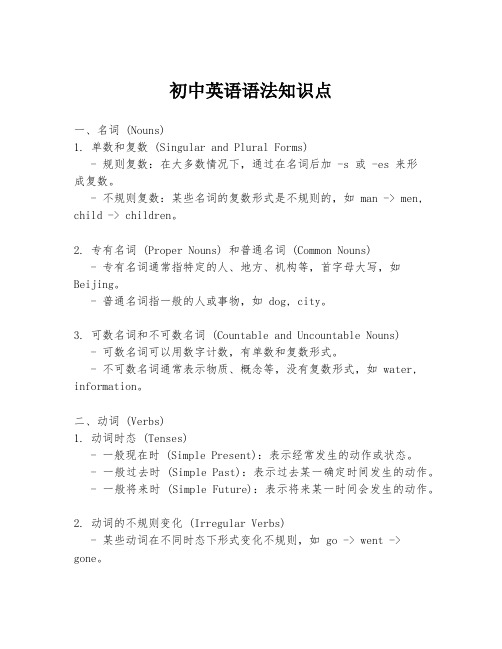
初中英语语法知识点一、名词 (Nouns)1. 单数和复数 (Singular and Plural Forms)- 规则复数:在大多数情况下,通过在名词后加 -s 或 -es 来形成复数。
- 不规则复数:某些名词的复数形式是不规则的,如 man -> men, child -> children。
2. 专有名词 (Proper Nouns) 和普通名词 (Common Nouns)- 专有名词通常指特定的人、地方、机构等,首字母大写,如Beijing。
- 普通名词指一般的人或事物,如 dog, city。
3. 可数名词和不可数名词 (Countable and Uncountable Nouns)- 可数名词可以用数字计数,有单数和复数形式。
- 不可数名词通常表示物质、概念等,没有复数形式,如 water, information。
二、动词 (Verbs)1. 动词时态 (Tenses)- 一般现在时 (Simple Present):表示经常发生的动作或状态。
- 一般过去时 (Simple Past):表示过去某一确定时间发生的动作。
- 一般将来时 (Simple Future):表示将来某一时间会发生的动作。
2. 动词的不规则变化 (Irregular Verbs)- 某些动词在不同时态下形式变化不规则,如 go -> went -> gone。
3. 助动词 (Auxiliary Verbs)- 助动词用于构成否定句、疑问句和某些时态,如 do, does, did。
三、形容词 (Adjectives)1. 形容词的比较级和最高级 (Comparative and Superlative Forms) - 比较级:用于比较两个事物,通常在形容词后加 -er 或使用more。
- 最高级:用于比较三个或以上事物,通常在形容词后加 -est 或使用 most。
2. 形容词的顺序 (Order of Adjectives)- 形容词通常按照一定的顺序排列,如 opinion, size, age, shape, color, origin, material, purpose。
初中英语语法大全(精华版)

初中英语语法大全(精华版)一、词法1. 名词名词是表示人、事物、地点或抽象概念的词。
名词有可数名词和不可数名词之分。
(1) 可数名词可数名词有单数和复数两种形式。
复数形式通常在单数形式后加上s或es。
(2) 不可数名词不可数名词没有复数形式,表示的是无法分割的整体或抽象概念。
2. 冠词冠词是放在名词前面的词,用来表示名词的特指或泛指。
(1) 不定冠词a/an不定冠词a用于辅音音素开头的单词前,an用于元音音素开头的单词前。
(2) 定冠词the定冠词the表示特指,即指说话人和听话人都知道的特定的人或事物。
3. 代词代词是用来代替名词的词,包括人称代词、物主代词、指示代词等。
(1) 人称代词人称代词有主格、宾格和所有格三种形式。
(2) 物主代词物主代词表示所有关系,分为形容词性物主代词和名词性物主代词。
(3) 指示代词指示代词用来指代前面提到的人或事物,有this/that/these/those等。
4. 形容词形容词是用来修饰名词的词,表示人或事物的性质、状态等。
5. 副词副词是用来修饰动词、形容词、其他副词或全句的词,表示时间、地点、程度等。
二、句法1. 句子成分句子成分包括主语、谓语、宾语、定语、状语等。
(1) 主语主语是句子叙述的对象,表示句子讲述的是“谁”或“什么”。
(2) 谓语谓语是句子中表示动作、状态或存在的部分,说明主语“做什么”、“是什么”或“怎么样”。
(3) 宾语宾语是句子中表示动作的对象,表示动作的承受者。
(4) 定语定语是句子中修饰名词的成分,表示名词的性质、特征等。
(5) 状语状语是句子中表示时间、地点、原因、条件、程度等的成分。
2. 基本句型英语句子有五种基本句型,分别是:(1) 主语+谓语(2) 主语+谓语+宾语(3) 主语+谓语+宾语+宾语(4) 主语+谓语+宾语+宾语补足语(5) 主语+系动词+表语3. 简单句、并列句和复合句(1) 简单句简单句是由一个主语和一个谓语构成的句子。
初中英语语法总结大全
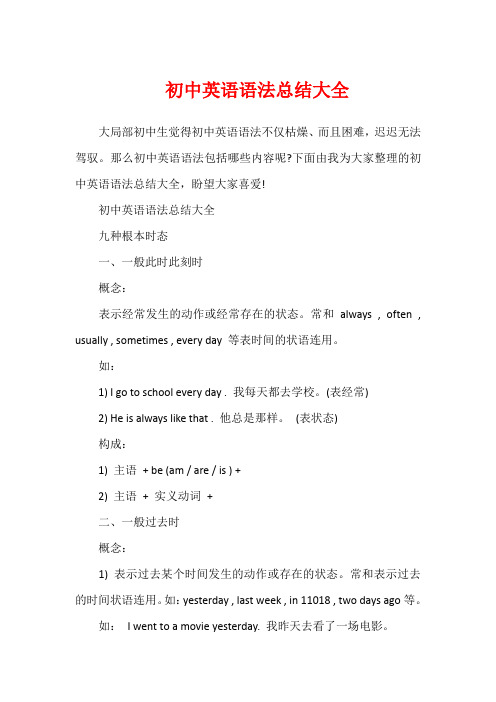
初中英语语法总结大全大局部初中生觉得初中英语语法不仅枯燥、而且困难,迟迟无法驾驭。
那么初中英语语法包括哪些内容呢?下面由我为大家整理的初中英语语法总结大全,盼望大家喜爱!初中英语语法总结大全九种根本时态一、一般此时此刻时概念:表示经常发生的动作或经常存在的状态。
常和always , often , usually , sometimes , every day 等表时间的状语连用。
如:1) I go to school every day . 我每天都去学校。
(表经常)2) He is always like that . 他总是那样。
(表状态)构成:1) 主语+ be (am / are / is ) +2) 主语+ 实义动词+二、一般过去时概念:1) 表示过去某个时间发生的动作或存在的状态。
常和表示过去的时间状语连用。
如:yesterday , last week , in 11018 , two days ago等。
如:I went to a movie yesterday. 我昨天去看了一场电影。
2) 也可表示过去经常或反复发生的动作。
如: He always went to work by bike last week.构成:1) 主语+ be (was / were ) +2) 主语+ 实义动词过去式+三、此时此刻进展时概念:表示此时此刻(说话瞬间)正在进展或发生的动作。
如:He is singing.They are watching TV now.构成:主语+ 助动词be(am/are/is) + 动词-ing形式构成.四、过去进展时概念:表示过去某一时刻或某一段时间正在进展的动作。
这一特定的过去时间除了有上下文示意外,一般用时间状语来表示。
如:1) ---What were you doing?---I was jumping.2) ---What was the boy doing when the UFO arrived?---He was sleeping.构成:主语+ 助动词be(was/were) + 动词-ing形式构成.五、一般将来时概念:表示将来某个时间要发生的动作或存在的状态,也表示将来经常或反复发生的动作,常与表示将来的时间状语连用。
初中英语语法大全归纳总结
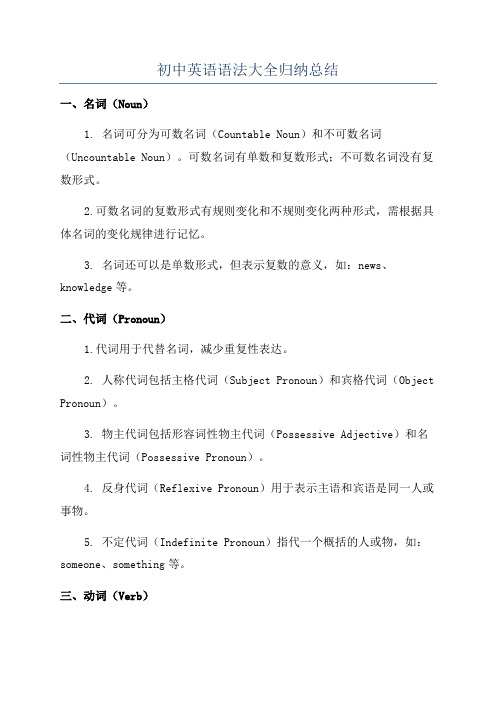
初中英语语法大全归纳总结一、名词(Noun)1. 名词可分为可数名词(Countable Noun)和不可数名词(Uncountable Noun)。
可数名词有单数和复数形式;不可数名词没有复数形式。
2.可数名词的复数形式有规则变化和不规则变化两种形式,需根据具体名词的变化规律进行记忆。
3. 名词还可以是单数形式,但表示复数的意义,如:news、knowledge等。
二、代词(Pronoun)1.代词用于代替名词,减少重复性表达。
2. 人称代词包括主格代词(Subject Pronoun)和宾格代词(Object Pronoun)。
3. 物主代词包括形容词性物主代词(Possessive Adjective)和名词性物主代词(Possessive Pronoun)。
4. 反身代词(Reflexive Pronoun)用于表示主语和宾语是同一人或事物。
5. 不定代词(Indefinite Pronoun)指代一个概括的人或物,如:someone、something等。
三、动词(Verb)1. 动词表示行动、存在或状态,分为及物动词(Transitive Verb)和不及物动词(Intransitive Verb)。
2. 动词的形式变化包括一般现在时(Simple Present)、一般过去时(Simple Past)、现在进行时(Present Continuous)、一般将来时(Simple Future)等。
3.动词的时态变化需掌握时态动词的构成规律和具体用法。
四、形容词(Adjective)和副词(Adverb)1.形容词用于修饰名词,描述名词的性质或状态;副词用于修饰动词、形容词或其他副词。
3.形容词和副词的比较级和最高级形式变化有规律变化和不规则变化两种情况。
五、介词(Preposition)1. 介词用于表示名词或代词与其他单词之间的关系,如:in、on、at等。
2. 介词短语(Prepositional Phrase)是介词加上宾语构成的短语结构。
初中英语语法知识点整理总结

初中英语语法知识点整理总结1.一般现在时一般现在时用来表示经常性的动作、事实或客观真理。
主语为第三人称单数时,动词要加s或es。
2.一般过去时一般过去时用来表示过去发生的事件或状态。
动词过去式有规则动词和不规则动词之分。
3.现在进行时现在进行时表示现在正在进行的动作,动词的变形为:am/is/are + 动词-ing。
4.现在完成时现在完成时表示过去发生的动作对现在造成的影响或结果。
动词的变形为:have/has + 过去分词。
5.一般将来时一般将来时用来表示将来发生的动作或存在的状态。
动词的变形为:will + 动词原形。
6.一般过去将来时一般过去将来时用来表示过去一些时间点之后本该发生但未发生的动作或情况。
动词的变形为:would + 动词原形。
7.动词不定式动词不定式用来表示一种动作或状态,或用作名词、定语或状语。
一般情况下,不定式前要加to。
8.动词的时态和语态英语动词的时态主要有三个:一般时、进行时和完成时。
动词的语态有两个:主动语态和被动语态。
9.定冠词和不定冠词定冠词the用来特指一些人或物,不定冠词a/an用来泛指一个人或物。
10.物主代词物主代词用来表示所有关系,如my, your, his, her, its, our, their等。
11.可数名词和不可数名词可数名词有单数和复数之分,不可数名词只有单数形式。
12.复数名词的变化规则复数名词一般在词尾加-s,以s,x,sh,ch结尾的名词在词尾加-es,以辅音字母+y结尾的名词变y为i再加-es。
13.形容词比较级和最高级形容词比较级用于比较两者,最高级用于比较三者或以上的事物。
14.形容词和副词的用法形容词修饰名词,副词修饰动词、形容词和副词。
15.介词的用法介词用于连接名词或代词与其他词,表示时间、地点、方向、原因等关系。
16.物主形容词和物主代词物主形容词用于修饰名词,物主代词用于代替名词。
17.反身代词反身代词用于强调一个人或物是动作的承受者或产生者。
初中英语语法大全知识点总结

初中英语语法大全知识点总结1. 词类分类名词- 名词是指人、物、地方、抽象概念等的名称。
- 可数名词可以数和分为单数和复数形式,不可数名词不能数。
- 可数名词的复数形式一般在词尾加s,但也有一些特殊变化。
- 名词的作用:主语、宾语、表语、定语、补语等。
代词- 代词用来代替名词,便于避免重复。
- 人称代词分为第一人称(I,we)、第二人称(you)、第三人称(he,she,it,they)。
- 物主代词表示所有关系,包括形容词性物主代词和名词性物主代词。
动词- 动词是句子的核心词,用来表示动作、状态或存在。
- 动词的时态包括一般现在时、一般过去时、一般将来时等。
形容词- 形容词用来描述名词的特征或状态。
- 形容词有比较级和最高级形式,用来进行比较。
副词- 副词用来修饰动词、形容词和其他副词。
- 副词可以表示时间、地点、方式、程度等。
介词- 介词用来表示名词与其他句子成分之间的关系。
- 常见的介词有in,on,at,of,to等。
连词- 连词用来连接词语、短语、从句等。
- 常见的连词有and,but,or,if,because等。
冠词- 冠词包括定冠词(the)和不定冠词(a,an)。
- 定冠词用来特指某个已知的人或事物,不定冠词用来泛指。
2. 句子结构主谓结构- 主谓结构是最基本的句子结构,由主语和谓语构成。
主谓宾结构- 主谓宾结构在主谓结构的基础上加上宾语。
- 宾语可以是名词、代词、动名词或不定式等。
主系表结构- 主系表结构由主语、系动词和表语构成。
- 系动词用来连接主语和表语,表示主语的状态、特征等。
否定句- 否定句中加入not,表示否定的意思。
一般疑问句- 一般疑问句是以助动词或be动词开头的问句。
- 对一般疑问句的回答可以用yes或no。
特殊疑问句- 特殊疑问句用来询问特定的信息,以特殊疑问词开头。
祈使句- 祈使句用来表示命令、请求、建议等,一般省略主语。
感叹句- 感叹句用来表示强烈的感情或意见,一般以感叹词开头。
(完整版)初中英语语法知识点归纳
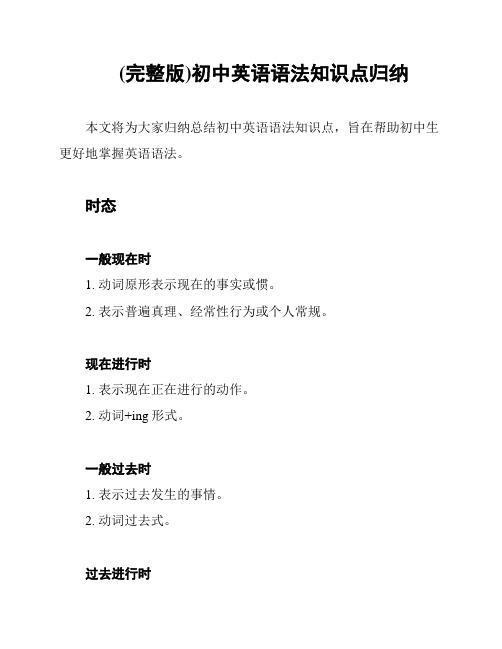
(完整版)初中英语语法知识点归纳本文将为大家归纳总结初中英语语法知识点,旨在帮助初中生更好地掌握英语语法。
时态一般现在时1. 动词原形表示现在的事实或惯。
2. 表示普遍真理、经常性行为或个人常规。
现在进行时1. 表示现在正在进行的动作。
2. 动词+ing形式。
一般过去时1. 表示过去发生的事情。
2. 动词过去式。
过去进行时1. 表示过去某个时间正在进行的动作。
2. was/were + 动词+ing形式。
一般将来时1. 表示将来的动作或状态。
2. will/shall + 动词原形。
语态主动语态1. 表示主语是动作的执行者。
2. 主语 + 动词原形。
被动语态1. 表示主语是动作的承受者。
2. be + 过去分词。
比较级与最高级比较级1. 用于比较两个人或物。
2. 形容词 + er。
最高级1. 用于比较三个或更多人或物。
2. 形容词 + est。
祈使句祈使句1. 表示请求、命令、建议或劝告。
2. 动词原形。
倒装句倒装句1. 将助动词或情态动词提前至主语之前。
2. 系动词be的倒装句:is/am/are/was/were + 主语。
直接引语与间接引语直接引语1. 直接引用他人的话。
2. 用引号将原话括起来。
间接引语1. 用自己的话转述他人的话。
2. 没有引号。
以上是初中英语语法的主要知识点归纳。
希望这份文档能够帮助到您更好地学习和掌握英语语法知识。
初中英语语法知识点整理总结(超详细)

初中英语语法知识点整理总结(超详细),学霸人手一份!果断收藏!一、词类、句子成分和构词法:一). 词类:英语词类分十种:名词(n.)表示人、事物、地点或抽象概念的名称boy, morning, bag, ball, class代词(pron.)主要用来代替名词who, she, you, it形容词(adj..)表示人或事物的性质或特征good, right, white, orange 数词(num.)表示数目或事物的顺序one,two,first,second,third 动词(v.)表示动作或状态am, is,are,have,see副词(adv.)修饰动词、形容词或其他副词,说明时间、地点、程度等now, very, here, often,slowly冠词(art..)用在名词前,帮助说明名词a, an, the介词(prep.)表示它后面的名词或代词与其他句子成分的关系in, on, from, above, behind连词(conj.)用来连接词、短语或句子and, but, before 感叹词(interj..)表示喜、怒、哀、乐等感情oh, well, hi, hello 二). 句子成分:英语句子成分分七种:主语、谓语、宾语、定语、状语、表语、宾语补足语。
1、主语:句子的主体,全句述说的对象。
回答是“谁”或者“什么”。
一般由名词、代词、不定式、动名词或从句担当,位于句首。
如:The boy needs a pen.Smoking is bad for you = To smoke is bad for you2、谓语:说明主语的动作或状态。
回答“做(什么)”。
由动词或系动词加表语担任,常置于主语后。
如:The train leaves at 6 o’clock.She is reading.3、宾语:表示动作的对象。
回答做的是“什么”。
一般由名词或代词担当,常置于谓语后。
初中英语语法大全(精华版)

初中英语语法大全(精华版)一、动词时态1. 一般现在时:表示经常性、习惯性的动作或状态。
例如:He goes to school bike every day.(他每天骑自行车上学。
)2. 一般过去时:表示过去某个时间里发生的动作或存在的状态。
例如:She visited her grandparents last weekend.(她上周末去看望了她的祖父母。
)3. 一般将来时:表示将来要发生的动作或状态。
例如:We will have a sports meeting next month.(下个月我们将举行一场运动会。
)4. 现在进行时:表示正在进行的动作或状态。
例如:The boy is reading a book in the library.(这个男孩正在图书馆看书。
)5. 过去进行时:表示过去某个时刻正在进行的动作或状态。
例如:They were watching TV when I called them last night.(昨晚我给他们打电话时,他们正在看电视。
)6. 现在完成时:表示过去发生的动作对现在造成的影响或结果。
例如:I have finished my homework.(我已经完成了我的家庭作业。
)二、名词1. 名词的分类:名词分为可数名词和不可数名词。
可数名词有单数和复数形式,不可数名词没有复数形式。
2. 名词的数:可数名词的复数形式通常在词尾加s或es。
例如:books(书),pencils(铅笔)。
3. 名词的所有格:表示某物属于某人或某事物的关系。
例如:Tom's book(汤姆的书),the teacher's desk(老师的桌子)。
三、冠词1. 不定冠词:a和an。
a用于辅音音素开头的单词前,an用于元音音素开头的单词前。
例如:a dog(一条狗),an apple(一个苹果)。
2. 定冠词:the。
表示特指,指某个特定的人或事物。
初中英语语法基础学习知识汇总
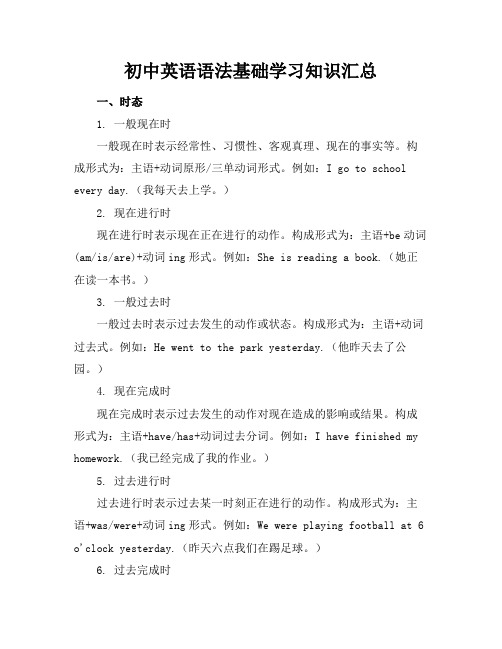
初中英语语法基础学习知识汇总一、时态1. 一般现在时一般现在时表示经常性、习惯性、客观真理、现在的事实等。
构成形式为:主语+动词原形/三单动词形式。
例如:I go to school every day.(我每天去上学。
)2. 现在进行时现在进行时表示现在正在进行的动作。
构成形式为:主语+be动词(am/is/are)+动词ing形式。
例如:She is reading a book.(她正在读一本书。
)3. 一般过去时一般过去时表示过去发生的动作或状态。
构成形式为:主语+动词过去式。
例如:He went to the park yesterday.(他昨天去了公园。
)4. 现在完成时现在完成时表示过去发生的动作对现在造成的影响或结果。
构成形式为:主语+have/has+动词过去分词。
例如:I have finished my homework.(我已经完成了我的作业。
)5. 过去进行时过去进行时表示过去某一时刻正在进行的动作。
构成形式为:主语+was/were+动词ing形式。
例如:We were playing football at 6 o'clock yesterday.(昨天六点我们在踢足球。
)6. 过去完成时过去完成时表示在过去某一时刻之前已经完成的动作。
构成形式为:主语+had+动词过去分词。
例如:She had learned English before she came to China.(她来中国之前已经学过英语了。
)二、被动语态被动语态表示主语是动作的承受者。
构成形式为:be动词(am/is/are/was/were/have/has/had)+过去分词。
例如:The book was written a famous author.(这本书是一位著名作家写的。
)三、情态动词情态动词表示能力、允许、请求、建议等。
常见的情态动词有:can, may, must, should等。
- 1、下载文档前请自行甄别文档内容的完整性,平台不提供额外的编辑、内容补充、找答案等附加服务。
- 2、"仅部分预览"的文档,不可在线预览部分如存在完整性等问题,可反馈申请退款(可完整预览的文档不适用该条件!)。
- 3、如文档侵犯您的权益,请联系客服反馈,我们会尽快为您处理(人工客服工作时间:9:00-18:30)。
二). 句子成分:英语句子成分分七种:主语、谓语、宾语、定语、状语、表语、宾语补足语。
1、主语:句子的主体,全句述说的对象。
回答是“谁”或者“什么”。
一般由名词、代词、不定式、动名词或从句担当,位于句首。
如:The boy needs a pen.Smoking is bad for you = To smoke is bad for you2、谓语:说明主语的动作或状态。
回答“做(什么)”。
由动词或系动词加表语担任,常置于主语后。
如:The train leav es at 6 o’clock.She is reading.3、宾语:表示动作的对象。
回答做的是“什么”。
一般由名词或代词担当,常置于谓语后。
如:He won the game.He likes playing computer.注意:1) 有些及物动词带有两个宾语,一个指物(直接宾语),一个指人(间接宾语)。
间接宾语一般放在直接宾语前面。
如:He wrote me a letter . (他给我写了一封信)2) 有时可把介词to或for加在间接宾语前构成短语,放在直接宾语后面,来强调间接宾语。
如:He wrote a letter to me . (他给我写了一封信)4、表语:用以表述主语的特征、状态、身份等。
回答是“什么”或者“怎么样”。
一般由名词或形容词担任,置于系动词或be动词之后。
如:He is a student. We are tired.注意:除了be 系动词外,还有一些动词也可以用作系动词,1)表感官的动词: feel, smell, taste, sound, look, appear, seem 等。
2)表转变变化的动词: become, get, grow, turn, go等。
3)表延续的动词: remain, keep, hold, stay, rest等。
5、定语:对名词或代词起修饰、限定作用的词、短语或句子。
如:The black bike is mine.(形容词)The boy in blue is Jim.(介词短语)I have nothing to do today.(动词不定式)注意:1)当定语修饰不定代词如:nothing , anything , everything , something等时,定语要放在其后作后置定语。
例如:I tell him something interesting. 2)不定式、短语或从句作定语时,也放在被修饰的名词之后。
例如:The boys who are in the room are playing games.6、状语:用以修饰动词、形容词、副词及全句,通常由形容词、代词、数词等担任位置灵活。
1)修饰形容词或副词时,通常位于被修饰的词之前;如:I am very sorry.2)表示时间、地点、目的的状语一般位于句子两头,强调时放在句首。
如:In order to cheer him up, I told him the truth.They are writing English in the classroom.3)一些表示不确定时间(如:often)或程度(如:almost)的副词状语通常位于be动词、助动词、情态动词之后,动词之前。
如:We often help him.He is always late for class.7、补语:补充说明宾语怎么样或干什么,。
由n./adj./介宾/分词/不定式等担任。
常位于宾语后。
如:He made me sad.(形容词)She asks me to take an umbrella.(不定式)The war made him a soldier.(名词)I find him at home.(介词短语)I saw a cat running along the wall.(分词)8、同位语:通常紧跟在名词、代词后面,进一步说明它的情况, 它可以由名词、代词、名词性短语或从句充当。
如:Tom, our monitor, is a handsome boy.I myself will do the experiment.She is the oldest among them six.一). 构词法:英语构词法主要有:合成法、派生法和转换法。
1、合成法:如:spaceship, headache, basketball, playground等等。
2、派生法:(1)派生名词:①动词+er/or ②动词+ing ③动词+(t)ion ④形容词+ness⑤其他,如:inventor, learner, swimming, congratulation, kindness, carelessness, knowledge(2)派生形容词:①名词+y ②名词+ful ③动词+ing/ed ④friendly ⑤dangerous ⑥Chinese; Japanese ⑦English ⑧French ⑨German ⑩国名+(i)an 如:snowy, sunny, hopeful, beautiful, interesting, follwing, daily(每日的),nervous, delicious(3)派生副词:①形容词+ly ②其它,如:slowly, angrily, full→fully, good→well, possible→possibly等等。
3、转换法:(1)形容词→动词,如:dry(干燥的)→dry(弄干), clean(干净的)→clean(打扫,弄干净),等等。
(2)动词→名词,如:look, walk, rest, work, study, swim, go, talk等等。
(3)名词→动词,如:hand(手)→(传递),face(脸)→(面对)等等。
(4)形容词→副词,如:early→early, fast→fast等等。
(5)副词→连词,如:when(什么时候)→(当……时候),等等。
(6)介词→副词,如:in(到……里)→(在里面;在家),on(在…上)→(进行,继续)。
一、名词:一). 名词的数1、可数名词一般是个体名词,如a boy(一个男孩),集体名词a family(一个家庭),可数名词在句子中必须有头或是有尾,头就是a,one,an或物主代词;尾就是复数形式。
1) 规则复数变化形式:情况构成方法读音例词一般情况加-s清辅音后读/s/,浊辅音读/z/ book→books key→keys以o结尾的表示有生命的名词加-es 读/z/tomato→tomatoespotato→potatoes以s,sh,ch,x等结尾的名词加-es 读/iz/bus→buseswatch→watchesbox→boxes3) 特殊的复数形式:a) 集体名词:集体名词不能运用具体的数字修饰,下面的集体名词,不能用a,one,two等修饰,只能在其前加the表示“全体……”。
the police警察(指全体警察) the English英国人(指全体英国人) b) 复合名词a woman teacher—women teachers女教师an Englishman—Englishmen英国男子a brother-in-law—brothers-in-law小叔、大伯a grown-up—grown-ups 成人2、不可数名词专有名词:NBA美篮协会Michael Jackson 迈克杰克逊the West Lake 西湖物质名词:液体:milk water tea coffee juice oil(油)肉类:beef chicken mutton pork天气:weather rain snow wind light 光其他:news(新闻,消息) bread(面包)抽象名词:fun love luck duty kindness善良happiness幸福progress进步【注意】有些不可数的物质名词有复数形式,但表达不同意义。
tea— different kinds of teas 不同种类的茶food 食品— all kinds of foods 各种各样的食品fruit 水果— all kinds of fruits 各种各样的水果glass 玻璃— a glass 一个玻璃杯— glasses 眼镜、玻璃杯一). 名词的格1、表示有生命的东西的名词所有格。
①一般在单数或复数名词后加-'s。
如:Tom's chair;the children's bedroom②以-s结尾的复数名词后直接加“'”。
如:the students' reading room③并列名词表示各自所属时,在两个名词之后都加’s;w表示共同所属时。
在最后一个名词后加's。
如:Tom and Mike's father 汤姆和迈克的父亲(俩人共有的父亲) Tom’s and Mike’s father s 汤姆的父亲和迈克的父亲(俩人各自的父亲)④表示店铺,某人的家,私人开的诊所、餐馆等,其所有格后的名词(如shop等)可以省略。
如:at Tom’s 在汤姆家里at the tailor's在裁缝店at a chemist's在药店2、表示无生命的东西的名词的所有格,常常用“of+名词”的形式。
1、主格用来做句子的主语、表语。
如: I often go shopping on Sundays.(星期天我常去购物)Are they from Brazil?(他们是巴西人吗?)That’s it.(就那么回事) / It’s he!(是他!)2、宾格用来做及物动词或者介词的宾语如:Who teaches you English this year?(今年谁教你们的英语?)Help me!(救救我!) / We often write letters to her.(我们常给他写信)3、人称代词作表语或者放在比较状语从句连词than或as之后时,可以用主格形式,也可以用宾格形式,口语中大多用宾格。
如:–It’s I/me.(是我。
)三个不同人称同时出现,或者主语中包含“我”时,按照“you→he→I”的顺序表达。
如:Both he and I are working at that computer company.(我和他都在那家电脑公司上班) –Who will go there?(谁要去那儿?) –You and me.(你和我)4、人称代词it除了可以指人指物之外,还可以表示“时间、天气、温度、距离、情况”等含义,此外还可以作“非人称代词”使用,替代作主语或者宾语的不定式、动名词或者名词性从句。
